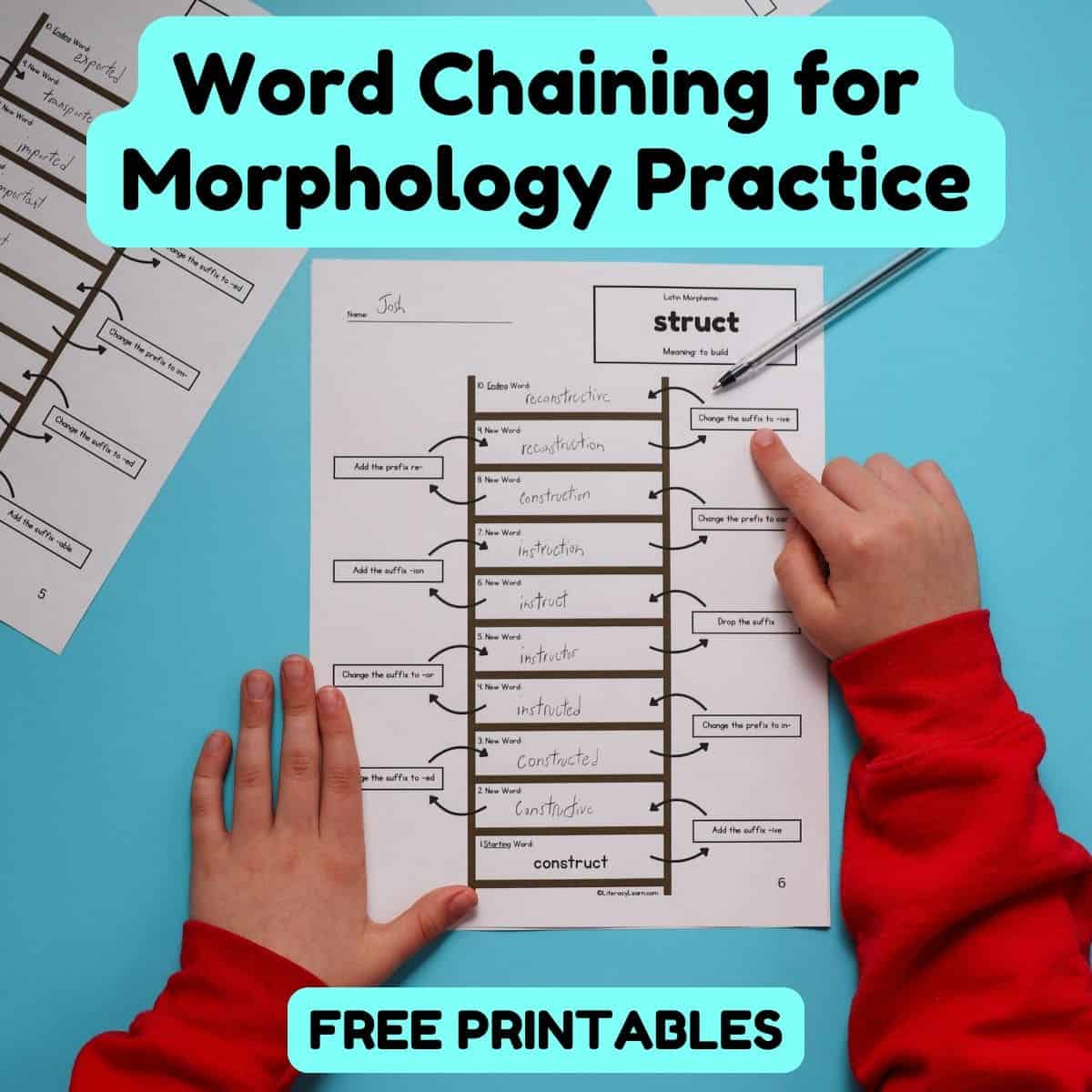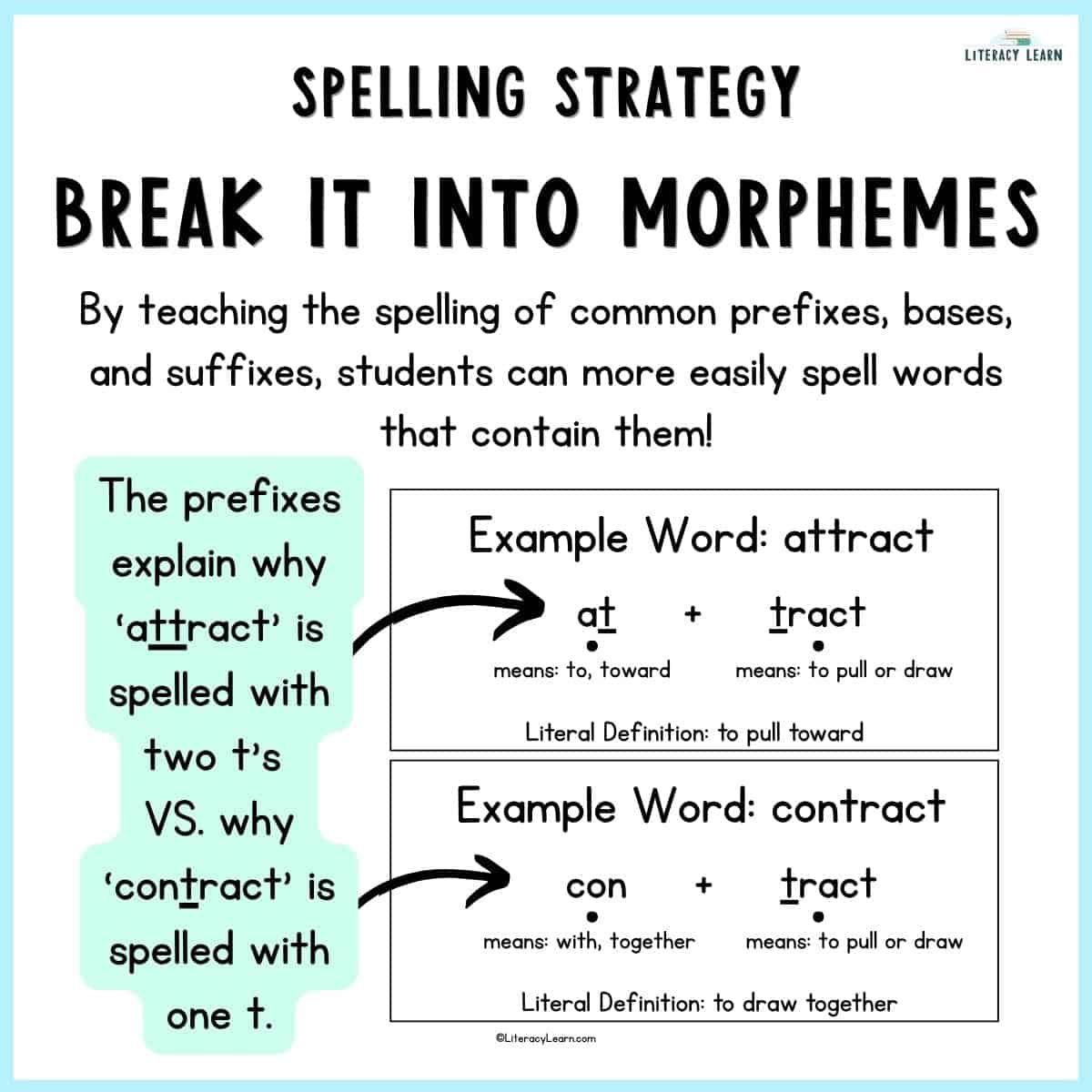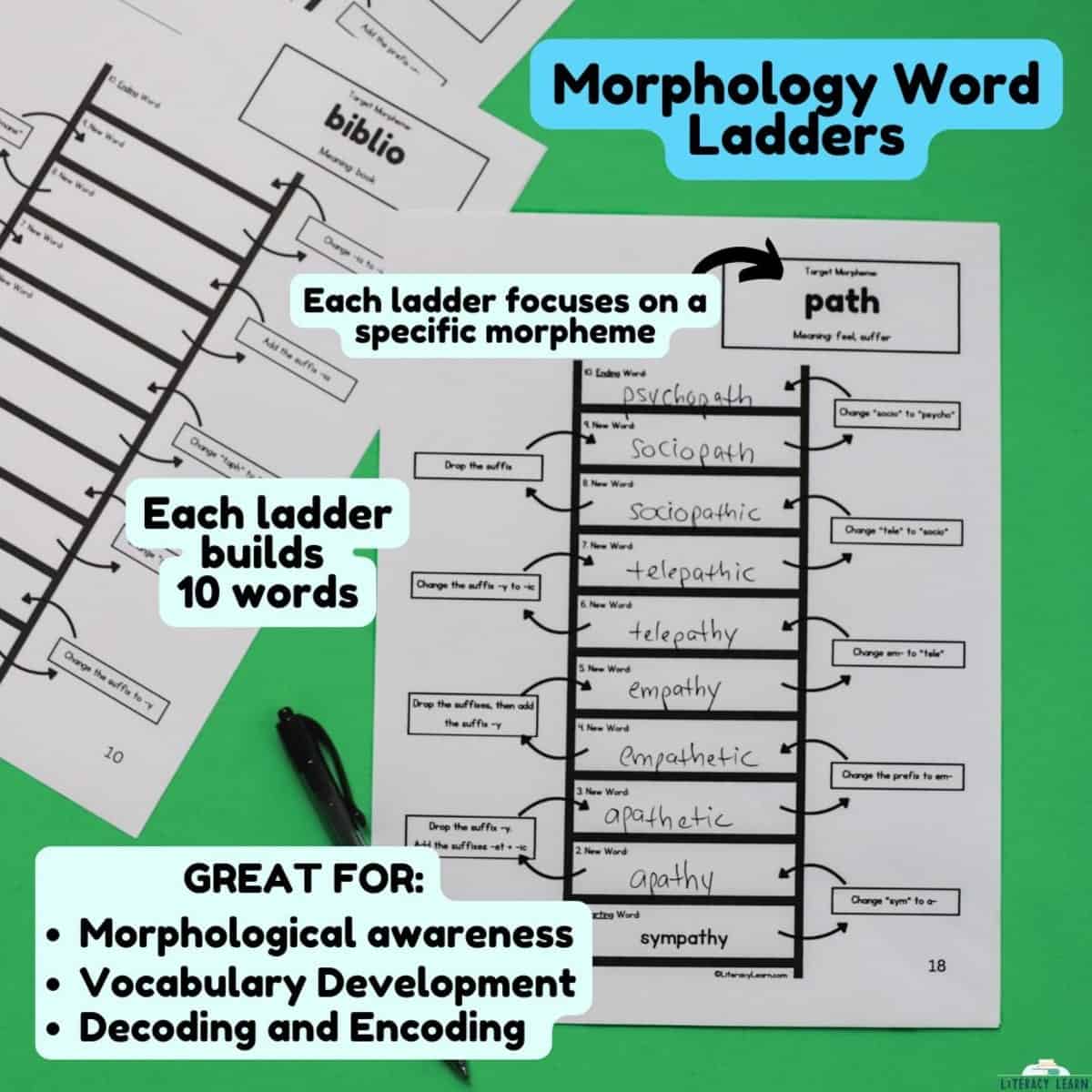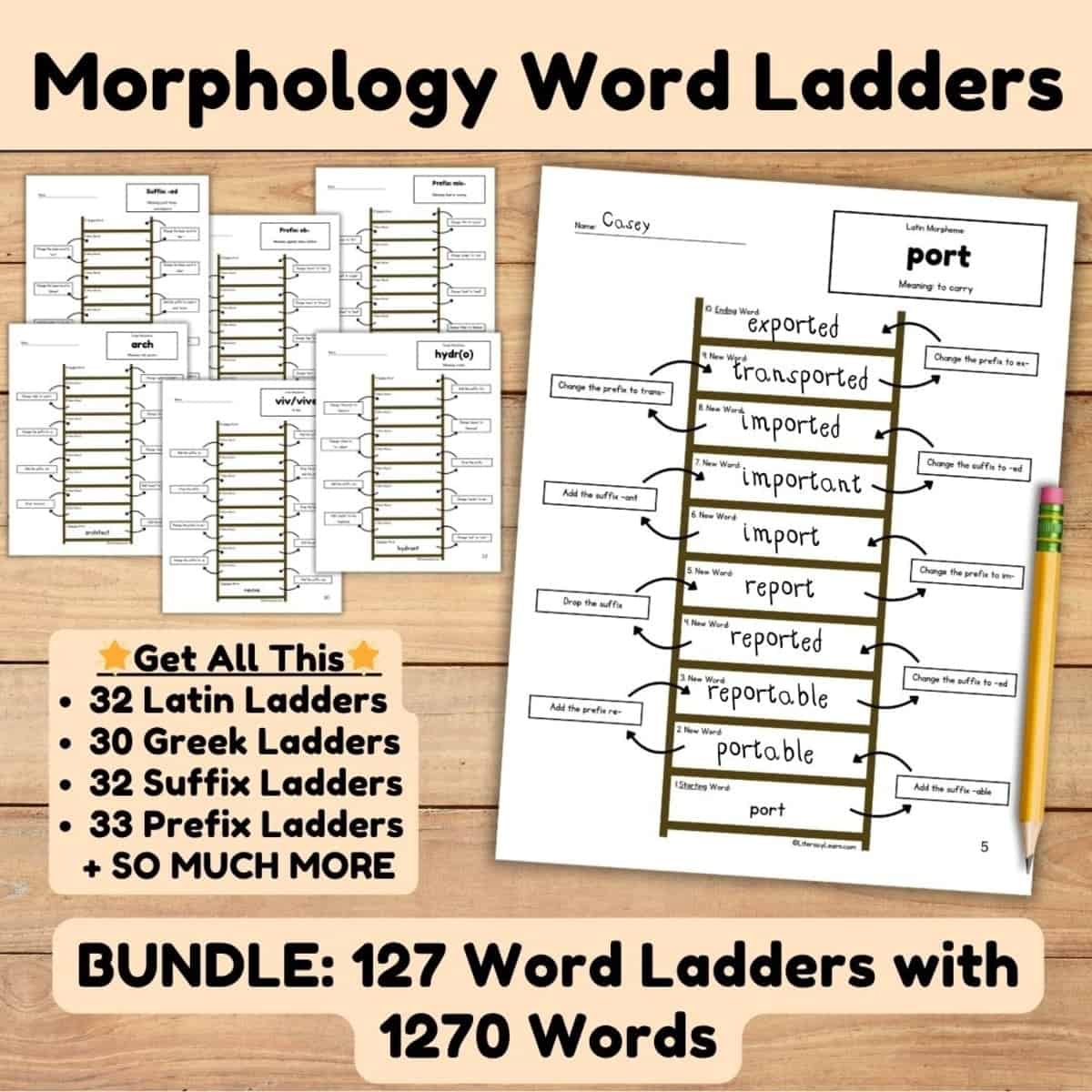Word Chaining for Powerful Morphology Practice
This post may contain affiliate links. As an Amazon affiliate, we earn from qualifying purchases.
Read on to learn how to use word chaining to deepen students’ understanding of morphemes (prefixes, suffixes, and base words) and get 4 free word ladders to help you get started right away.

What Is Word Chaining?
Traditionally, word-chaining activities (also called “word ladders”) are used as a tool to bridge phonemic awareness and phonics.
Students begin with one word and change one phoneme (sound) at a time. As the sounds change, they adjust the corresponding graphemes (letters) to spell each new word. This process helps build essential literacy skills, including the alphabetic principle, phonemic awareness, phonics, and vocabulary.
A sample word chain to practice these skills might look like this:
chat ➡ chap ➡ chop ➡ chip ➡ ship ➡ shin ➡ shun ➡ bun ➡ bin ➡ chin
👩🏽🏫 Read our article to learn more about phonics word chaining and get a free word ladder and 7 word lists!
Word Chaining for Morphology
For nearly two decades, I’ve used traditional word-chaining activities to help my students build strong skills. Now, I’ve taken that tried-and-true strategy and adapted it for morphology instruction, and the results are powerful!
Morphology word chains are a unique type of word-building activity. In these chains, students build a series of related words by changing one morpheme at a time—a prefix, suffix, or base.
Each word chain begins with a single word that includes the target morpheme. Students follow step-by-step directions to modify the word. These changes involve adding, removing, or replacing one morpheme per step.
Here’s an example of a morphology word chain, focused on the Latin base tract, meaning “to drag or pull:”
- Starting word: traction
- Add the prefix “re-” ➡ retraction
- Change the suffix to “-ive” ➡ retractive
- Change the prefix to “at-” ➡ attractive
- Drop the suffix ➡ attract
- Change the prefix to “sub-” ➡ subtract
- Add the suffix “-ing” ➡ subtracting
- Change the prefix to “pro-” ➡ protracting
- Change the prefix to “dis-” ➡ distracting
Each ladder focuses on one morpheme (like a Greek base, Latin base, prefix, or suffix) —to help students build a deeper understanding of how word meanings are connected.
In the above example, all 10 words include the Latin base tract: traction, retraction, retractive, attractive, attract, subtract, subtracting, protracting, and distracting.
💡 Lightbulbs begin going off when kids see the connections between words that share similar morphemes —and how changing just one morpheme in a word can affect the meaning.
Benefits of Using Word Ladders
Here are a few benefits I have observed since implementing this activity with my students:
1. Using word ladders builds an interest in words, and kids LOVE them!
“If we can get students interested in playing with words and languages, then we are least halfway to the goal of creating the sort of word-conscious students who will make words a lifetime interest.” – M. Graves (2000)
Word chaining provides meaningful word-play activities. My students consistently say this is their favorite morphology activity.
2. Word ladders expand students’ vocabularies. Kids must analyze the structure of words and make connections between similar words or word parts. This deepens their understanding of how words work, helping them recognize patterns and apply that knowledge when reading unfamiliar words.
3. Word ladders build essential literacy skills, like morphological awareness, vocabulary, encoding, and decoding skills in one activity. Because word ladders integrate multiple skills at once, they are a high-impact routine that supports overall literacy skills.
4. Helps with spelling accuracy. Teaching kids to spell by morphemes is a powerful spelling strategy. Research supports this (Bowers & Kirby, 2010).
Consider this example: the word attract has two t’s, while contract has only one. Why the difference? Morphology explains it! at+tract vs. con+tract.

When students understand how words are built from meaningful parts, they’re more likely to spell them correctly. This approach also reinforces important suffix spelling rules, like when to double, drop, and change patterns as morphemes are added.
5. Morphology instruction is super impactful for students with dyslexia because many tend to have weak phonemic processing skills.
🔗 Free Morphology Word Chains
Our NO-PREP word ladders are a must-have for anyone teaching morphology, vocabulary, or preparing students to tackle multisyllabic words with confidence!
To help get you started, we’re giving you 4 free worksheets for morphology word chaining! You’ll get 1 Latin base ladder (struct), 1 Greek base ladder (auto), one prefix ladder (un-), and one suffix ladder (-ion).

Once you start using them, you’ll be hooked. Especially when you see the way your students will respond. You’ll see your students’ enthusiasm for word structure and word play grow as you use them!
If you’re looking for more, check out our popular morphology word ladder products in our TPT store. You can get up to 127 NO-PREP word ladders for morphology, PLUS a whole lot more!
- Latin Word Ladders
- Greek Word Ladders
- Prefixes and Suffixes Word Ladders
- The Bundle – Greek, Latin, and Prefixes/Suffixes

We spent a lot of time designing these word ladders to make them super easy to use! They work great for whole group instruction, small group instruction, centers, or independent work.
More Morphology Resources
- Customizable Word Matrix
- Inflectional Suffix Bundle
- Science of Reading Morphology Poster
- Free Morphology Worksheets
- Morpheme Exploration
References: Bowers, P. N., & Kirby, J. R. (2010). Effects of morphological instruction on vocabulary acquisition. Reading and Writing, 23(5), 515–537.
🖨 Download & Print
DOWNLOAD TERMS: All of our resources and printables are designed for personal use only in homes and classrooms. Each teacher must download his or her own copy. You may not: Save our files to a shared drive, reproduce our resources on the web, or make photocopies for anyone besides your own students. To share with others, please use the social share links provided or distribute the link to the blog post so others can download their own copies. Your support in this allows us to keep making free resources for everyone! Please see our Creative Credits page for information about the licensed clipart we use. If you have any questions or concerns regarding our terms, please email us. Thank you!
⭐️ GET MORPHOLOGY FREEBIES: Free Morphology Worksheets, Customizable Word Matrix.
We love hearing from you! Have you tried using word chaining for morphology?


